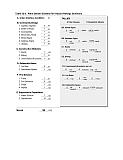32.0 Palm Garden Estates
32.1 Risk and Hazard Assessment
Palm Garden Estates is located in southern Clark County along Interstate 95, approximately seven miles south of CalNevAri. The community primarily consists of a mobile home park, with only four lots located in the wildland-urban interface. The community hazard assessment resulted in classifying Palm Garden Estates in the Low Hazard category (35 points). The rating is primarily attributed to good defensible space, sparse fuels, and non-combustible construction materials. A summary of the conditions that contributed to the hazard rating for Palm Garden Estates is included in Table 32-3 at the end of this section. The Palm Garden Estates community boundary is shown in Figure 32-1.
32.1.1 Community Design
The area surrounding Palm Garden Estates has a classic wildland-urban interface condition, with a clear line of demarcation between building structures and wildland fuels. Wildland vegetation typically does not continue into the developed areas. All homes are on lots of less than one acre in size.
- Access: The primary road into Palm Garden Estates is Interstate 95. The secondary roads have adequate turnaround space for fire suppression equipment to maneuver.
- Signage: Street signs and addresses are clearly visible throughout the community.
- Utilities: The utilities in Palm Garden Estates pose a low ignition risk.
32.1.2 Construction Materials
All of the homes in the interface are built with non-combustible roofing materials and have fire resistant siding materials.
None of the homes in the community have unenclosed balconies, porches, decks, or other architectural features that create drafts and provide areas where sparks and embers can be trapped, smolder, ignite, and rapidly spread fire to the home.
32.1.3 Defensible Space
All of the homes within the Palm Garden Estates community meet the defensible space landscaping requirement to minimize damage to the home or loss during a wildfire.
32.1.4 Suppression Capabilities
Wildfire Protection Resources
Fire suppression for Palm Garden Estates comes from CalNevAri, seven miles to the north on Interstate-95. The Clark County Fire Station 84 in CalNevAri is staffed by volunteer firefighters. Table 32-1 lists the suppression resources available to respond to a reported wildland fire in the Palm Garden Estates area. Additional municipal and county resources would be dispatched through the Clark County Fire Alarm Office.
| Type of Resource | Amount of Equipment | Cooperating Partner (Resource Location) |
|---|---|---|
| Water Tender Type 1 Structure Engine Type 6 Quick Attack Engine Intermediate Life Support (ILS) Rescue |
1 1 1 1 |
Clark County Rural Fire Station 84 (CalNevAri) |
| Source: Homeowner, pers. comm., March 2004. | ||
Mutual aid can be requested from the US Forest Service and the Bureau of Land Management through the Las Vegas Interagency Communications Center. The Nevada Division of Forestry also provides mutual aid dispatched from the Sierra Front Interagency Dispatch Center in Minden, Nevada, which locates the nearest available fire suppression resource according to incident command and computer aided dispatch protocols. It is important to note that these resources can be assigned to other emergency incidents during the fire season.
Water Sources and Infrastructure
Water available for fire suppression in Palm Garden Estates includes 500 gpm fire hydrants within 500 feet of the structures.
Detection and Communication
Wildland fires are reported by calls to 911. The Las Vegas Fire Alarm Office and local dispatch relay fires to local fire departments.
Community Preparedness
Clark County has an active Local Emergency Planning Committee and has adopted an all-risk, multi-agency emergency plan. The plan is reviewed annually and updated as needed.
32.1.5 Factors Affecting Fire Behavior
The vegetative fuel density in and around the Palm Garden Estates community is light dominated by sparse bursage, creosote bush, and annual grasses. The fuel hazard was considered low.
32.1.6 Fire Behavior Worst-case Scenario
The worst-case scenario would be a fire southwest of town driven by strong winds pushing fire northeast into the south and west side of the community. Structures have good defensible space, are fire resistant, and most likely would not be threatened in the unlikely event of a wildland fire.
32.1.7 Ignition Risk Assessment
Palm Garden Estates has a low wildfire ignition risk potential. There is no significant wildfire history in the area surrounding the community, and the recorded history of lightning strikes and other ignitions shows few incidents. The low ignition potential is facilitated by the low, sparse brush in and around the community.
32.2 Risk and Hazard Reduction Recommendations
32.2.1 Defensible Space Treatments
Defensible space treatments are an essential first line of defense for residential structures. The goal of the treatments is to significantly reduce or remove flammable vegetation within a prescribed distance from structures. (Refer to Appendix E for the recommended defensible space area) Defensible space reduces the fire intensity and improves firefighter and homeowner chances for successfully defending a structure against oncoming wildfire.
Property Owners
- Continue to maintain a minimum of thirty feet of defensible space around homes and property.
32.2.2 Fuel Reduction Treatments
Bureau of Land Management
Create and maintain a fuelbreak thirty feet wide around the perimeter of the community as shown in Figure 32-1. Mow vegetation to a maximum height of four inches.
32.3 Summary of Recommendations
| Involved Party | Recommended Treatment | Recommendation Description |
|---|---|---|
| Property Owners | Defensible Space | Continue to maintain a minimum thirty feet of defensible space as needed. |
| Bureau of Land Management | Fuels Reduction | Create and maintain a fuelbreak thirty feet wide around the community perimeter. |
Table 32-3. Palm Garden Estates Wildfire Hazard Rating Summary |
 |
Figure 32-1 Palm Garden Estates Proposed Mitigation Projects |
 |
